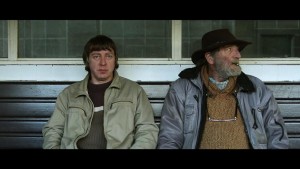What’s “real” cinéma vérité? Two recent festival films show us the real thing.
“real” cinéma vérité? Two recent festival films show us the real thing.
A great work of cinéma vérité makes it easy for you to believe that you’ve been given a window into someone else’s reality, and to be grateful for that opportunity. An experience that seemingly simple takes a lot of craft, as well as a respect for and trust in both subject and audience.
That’s what happens in Sabine Lubbe Bakker and Niels van Koevorden’s “Ne Me Quitte Pas,” just shown at Tribeca Film Festival. And that is quite an achievement, since it’s about two middle-aged Belgian drunks as they bumble through their days. One drunk’s wife has recently left him; the film follows him and the other as he attempts to come to grips with his life and figure out next steps. His buddy can be consoling, but he also encourages sloppy foolishness that puts them both in danger. Only when the first drunk decides to go into rehab is the alcohol-fueled relationship jeopardized—but not for long.
Up Close with Drunks.
“Ne Me Quitte Pas” should really bore you when it doesn’t disgust you. These gentlemen are hapless. Furthermore, it should make you claustrophobic; you’re really close to these guys, even when they’re getting sick and careening perilously around the bend.
But instead the skill of the storytellers takes us over. The filmmakers exercised extraordinarily quiet, patient observational technique. They were present and tightly close for wildly improbable moments, such that the scenes can feel like a fiction film. The editing is unpretentiously elegant, never paced beyond the rhythm of the men’s days. They succeed in finding comedy without mocking the subjects.
Most of all, the film doesn’t sit in judgment on these men. It doesn’t justify, excuse, condemn or invest us in hoping to save them. It brings us into lost lives that we don’t have to judge either. It invites us to exercise compassion. Wow.
The Ladies Who Sing in the Square.
 I saw the immense skill required for a limpid cinéma vérité experience as well in “Que Caramba Es la Vida” by Doris Dörrie, which just showed at SXSW in March.
I saw the immense skill required for a limpid cinéma vérité experience as well in “Que Caramba Es la Vida” by Doris Dörrie, which just showed at SXSW in March.
The film introduced me to several women in Mexico City, each distinctive in her approach to the work of singing mariachi for family events. The dour and fierce singer, who sings of the anguish of life; the sunny girl band in their neatly tailored matching uniforms, giggling at what their manager has to put up with; the retired ladies who pioneered the way for the girl band and recall a more formal era in the business—each of them was full of stories that were only a piece of how we got to know them. There was also the round of daily work, the interactions with clients, with family, with colleagues and friends, and with the remarkable music.
Dörrie is also a palpable presence in the film. Although we don’t see her, we see the women talk to her, often about men and family and the challenge of doing work that is traditionally reserved for men. But she’s not obtrusive. The camera quietly accompanies the women, sometimes at a discreet distance, mindful of their responsibilities. The film’s editing neatly weaves the stories of the women together, paced neither to rush nor to linger but instead to let us see their lives like the visitors we are.
I thought I disliked mariachi music, and maybe I still do, but I loved listening to those women sing, with all the love and anger and wit and cultural connection that gave it meaning. Dörrie, a renowned German filmmaker and a feminist, gave me an intimate sense of being in the moment with women I was happy to meet. It was an experience I was grateful for, one that has lingered with me long after.
Where’s the Real Cinéma Vérité?
Theres a long and snarky tradition of rediscovering—shock, shock—that cinéma vérité isn’t actually a transparent window on reality. This always gives otherwise interesting filmmakers like Errol Morris and Fred Wiseman and Nick Broomfield to stamp their feet and have an anti-critical moment, shrugging off labels. But that doesn’t make a tradition of bringing viewers into experience with craft go away.
When filmmakers in good faith bring us intimately and extendedly into an experience—whether it’s in “The Interrupters,” or “The E-Team,” or “Ne Me Quitte Pas” or “Que Caramba Es La Vida”—and we don’t feel abused or bored or like we have trespassed, they are bringing the craft of cinema to the challenge of portraying real life. They’re giving us the gift of respect for people whose lives we have probably never imagined.
Of course it’s artifice, like the rest of human expression. But it’s artifice in the service of a humanist understanding, of empathy in a world that’s short of it. For all the filmmakers who think that cinéma vérité gets them out of taking responsibility for good editing and decent lighting, let them take apart films like these and study them. That’s craft.
